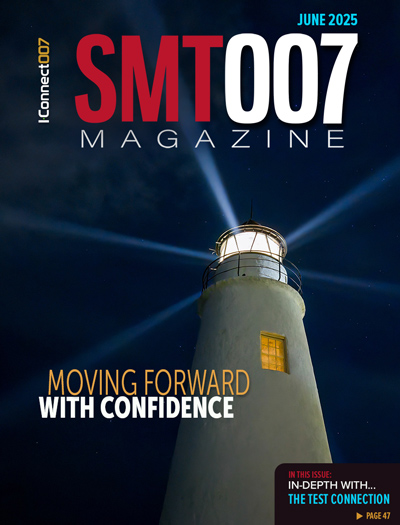-

- News
- Books
Featured Books
- smt007 Magazine
Latest Issues
Current Issue
What's Your Sweet Spot?
Are you in a niche that’s growing or shrinking? Is it time to reassess and refocus? We spotlight companies thriving by redefining or reinforcing their niche. What are their insights?

Moving Forward With Confidence
In this issue, we focus on sales and quoting, workforce training, new IPC leadership in the U.S. and Canada, the effects of tariffs, CFX standards, and much more—all designed to provide perspective as you move through the cloud bank of today's shifting economic market.

Intelligent Test and Inspection
Are you ready to explore the cutting-edge advancements shaping the electronics manufacturing industry? The May 2025 issue of SMT007 Magazine is packed with insights, innovations, and expert perspectives that you won’t want to miss.
- Articles
- Columns
- Links
- Media kit
||| MENU - smt007 Magazine
Lockheed Martin-Built GOES-U Weather Satellite Successfully Launched
July 1, 2024 | Lockheed MartinEstimated reading time: 2 minutes
An advanced weather satellite built by Lockheed Martin for the National Oceanic and Atmospheric Administration (NOAA) launched from NASA's Kennedy Space Center. Lifted to space aboard a Space X Falcon Heavy rocket, the GOES-U satellite successfully deployed its large solar array to generate electrical power and has established communications with mission operators.
GOES-U is the final satellite in NOAA's Geostationary Operational Environmental Satellites (GOES) - R series of four satellites. After it reaches geostationary orbit, approximately two weeks after launch, GOES-U will be renamed GOES-19. Once in operations over the East Coast of North America, the satellite be known as GOES East, and will provide advanced weather imagery, atmospheric measurements and real-time mapping of lightning activity, in addition to critical space weather observations.
"The launch of GOES-U is the culmination of more than 16 years of designing, building and launching four important weather satellites for our nation," said Jagdeep Shergill, GOES-U program manager and director of Geo Weather Programs at Lockheed Martin. "Since the launch of the first GOES-R satellite, our nation has had more accurate weather forecasts and more timely severe storm warnings, and this critical service has positively affected everyone in the U.S."
NOAA's GOES-R satellites, and soon GOES-U, provide crucial data for weather forecasting, severe storm tracking and climate monitoring. With their advanced instruments and rapid updates, they improve detection of atmospheric phenomena like hurricanes, wildfires and lighting. This real-time data aids the National Weather Service and meteorologist in early warnings, disaster preparedness and resource management, ultimately saving lives and mitigating economic losses.
The GOES-U spacecraft features two high-tech instruments built by Lockheed Martin's Advanced Technology Center in Palo Alto, California:
Geostationary Lightning Mapper (GLM), which is a first-of-its-kind operational lightning mapper that tracks lightning across the U.S. in real-time. GLM allows meteorologists to quickly identify intensifying storms and take appropriate action. In 2020, GLM captured a lightning megaflash nearly 500 miles long that broke the world record for longest lightning flash.
Solar Ultraviolet Imager (SUVI), focuses on space weather and measures the sun in extreme ultraviolet wavelength range. SUVI is essential to understanding active areas on the sun and predicting solar events that may disrupt power utilities, communication or navigation systems here on Earth.
GOES-U is the final satellite of the GOES-R series which will provide critical weather and climate date into the 2030s. Following GOES-U, Lockheed Martin was selected by NASA to develop the nation's next generation weather satellite constellation, Geostationary Extended Observations (GeoXO), for NOAA. GeoXO's new capabilities will deliver more accurate weather forecasting and address emerging environmental issues and challenges. GeoXO, the GOES-R series and the nation's weather satellites are vital infrastructure for national resilience.
NOAA funds, manages and will operate the GOES-R series satellites. NASA oversees the acquisition and development of the GOES-R spacecraft, instruments and launch vehicles. The program is co-located at NASA's Goddard Space Flight Center in Greenbelt, Maryland.
Testimonial
"We’re proud to call I-Connect007 a trusted partner. Their innovative approach and industry insight made our podcast collaboration a success by connecting us with the right audience and delivering real results."
Julia McCaffrey - NCAB GroupSuggested Items
Lockheed Martin Awarded GeoXO Lightning Mapper Contract to Support Forecasters with Severe Weather Monitoring
09/19/2024 | Lockheed MartinNASA has awarded Lockheed Martin (NYSE: LMT) a contract to design and build the next-generation GeoXO Lightning Mapper (LMX) instruments for the National Oceanic and Atmospheric Administration (NOAA).
Lockheed Martin Selected To Develop Next Generation Weather Satellite Constellation
06/20/2024 | Lockheed MartinNASA has selected Lockheed Martin to develop and build the nation's next generation weather satellite constellation, Geostationary Extended Observations (GeoXO), for the National Oceanic and Atmospheric Administration (NOAA).
NOAA’s Newest Weather Satellite from Lockheed Martin Arrives In Florida To Begin Launch Preparations
01/29/2024 | Lockheed MartinThe next-generation Geostationary Operational Environmental Satellite (GOES)-U has successfully arrived at Kennedy Space Center, Florida, to begin preparing for its spring launch.
Going Green at SEL
08/23/2023 | Barry Matties, I-Connect007SEL is going green at its new 162,000-square-foot, environmentally friendly PCB manufacturing facility in Moscow, Idaho. As John Hendrickson explains, being a zero liquid discharge (ZLD) facility—a trend you are likely to hear more of in our industry—is not just a smart business decision, it’s driven by SEL’s core values.
IPC Rolls Out Red Carpet for Standards A-Team Volunteers at Annual Golden Gnome Awards Ceremony at IPC SummerCom
06/07/2023 | IPCThe third annual Golden Gnome Awards ceremony was held on May 16, 2023, at IPC SummerCom. The awards recognize the outstanding and creative work of IPC A-Teams, dedicated groups of volunteers within IPC standards working groups who take on a significant amount of work on behalf of their groups.


